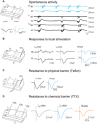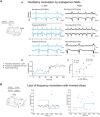Modulation of intercolumnar synchronization by endogenous electric fields in cerebral cortex
- PMID: 33658192
- PMCID: PMC7929504
- DOI: 10.1126/sciadv.abc7772
Modulation of intercolumnar synchronization by endogenous electric fields in cerebral cortex
Abstract
Neurons synaptically interacting in a conductive medium generate extracellular endogenous electric fields (EFs) that reciprocally affect membrane potential. Exogenous EFs modulate neuronal activity, and their clinical applications are being profusely explored. However, whether endogenous EFs contribute to network synchronization remains unclear. We analyzed spontaneously generated slow-wave activity in the cerebral cortex network in vitro, which allowed us to distinguish synaptic from nonsynaptic mechanisms of activity propagation and synchronization. Slow oscillations generated EFs that propagated independently of synaptic transmission. We demonstrate that cortical oscillations modulate spontaneous rhythmic activity of neighboring synaptically disconnected cortical columns if layers are aligned. We provide experimental evidence that these EF-mediated effects are compatible with electric dipoles. With a model of interacting dipoles, we reproduce the experimental measurements and predict that endogenous EF-mediated synchronizing effects should be relevant in the brain. Thus, experiments and models suggest that electric-dipole interactions contribute to synchronization of neighboring cortical columns.
Copyright © 2021 The Authors, some rights reserved; exclusive licensee American Association for the Advancement of Science. No claim to original U.S. Government Works. Distributed under a Creative Commons Attribution License 4.0 (CC BY).
Figures




References
-
- Steriade M., Contreras D., Curró Dossi R., Nuñez A., Houtkooper R. H., Auwerx J., Franken P., Tafti M., The slow (< 1 Hz) oscillation in reticular thalamic and thalamocortical neurons: Scenario of sleep rhythm generation in interacting thalamic and neocortical networks. J. Neurosci. 13, 3284–3299 (1993). - PMC - PubMed
-
- Sanchez-Vives M. V., Massimini M., Mattia M., Shaping the default activity pattern of the cortical network. Neuron 94, 993–1001 (2017). - PubMed
-
- Anastassiou C. A., Perin R., Markram H., Koch C., Ephaptic coupling of cortical neurons. Nat. Neurosci. 14, 217–223 (2011). - PubMed
-
- Jefferys J. G. R., Nonsynaptic modulation of neuronal activity in the brain: Electric currents and extracellular ions. Physiol. Rev. 75, 689–723 (1995). - PubMed
Publication types
LinkOut - more resources
Full Text Sources
Other Literature Sources

